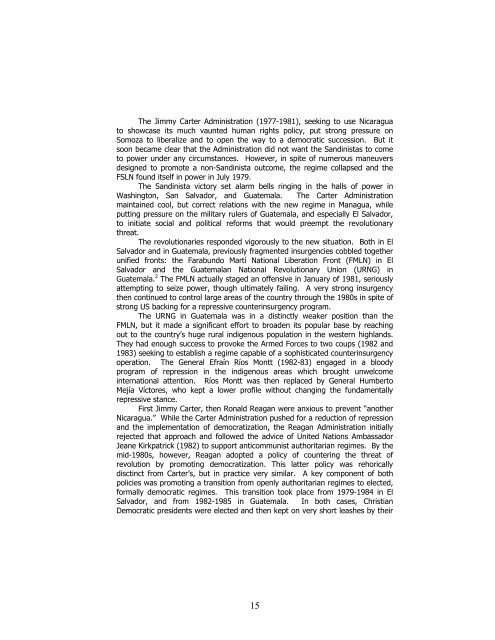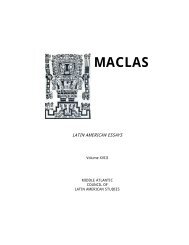latin american essays maclas
latin american essays maclas
latin american essays maclas
Create successful ePaper yourself
Turn your PDF publications into a flip-book with our unique Google optimized e-Paper software.
The Jimmy Carter Administration (1977-1981), seeking to use Nicaragua<br />
to showcase its much vaunted human rights policy, put strong pressure on<br />
Somoza to liberalize and to open the way to a democratic succession. But it<br />
soon became clear that the Administration did not want the Sandinistas to come<br />
to power under any circumstances. However, in spite of numerous maneuvers<br />
designed to promote a non-Sandinista outcome, the regime collapsed and the<br />
FSLN found itself in power in July 1979.<br />
The Sandinista victory set alarm bells ringing in the halls of power in<br />
Washington, San Salvador, and Guatemala. The Carter Administration<br />
maintained cool, but correct relations with the new regime in Managua, while<br />
putting pressure on the military rulers of Guatemala, and especially El Salvador,<br />
to initiate social and political reforms that would preempt the revolutionary<br />
threat.<br />
The revolutionaries responded vigorously to the new situation. Both in El<br />
Salvador and in Guatemala, previously fragmented insurgencies cobbled together<br />
unified fronts: the Farabundo Martí National Liberation Front (FMLN) in El<br />
Salvador and the Guatemalan National Revolutionary Union (URNG) in<br />
Guatemala. 2 The FMLN actually staged an offensive in January of 1981, seriously<br />
attempting to seize power, though ultimately failing. A very strong insurgency<br />
then continued to control large areas of the country through the 1980s in spite of<br />
strong US backing for a repressive counterinsurgency program.<br />
The URNG in Guatemala was in a distinctly weaker position than the<br />
FMLN, but it made a significant effort to broaden its popular base by reaching<br />
out to the country’s huge rural indigenous population in the western highlands.<br />
They had enough success to provoke the Armed Forces to two coups (1982 and<br />
1983) seeking to establish a regime capable of a sophisticated counterinsurgency<br />
operation. The General Efraín Ríos Montt (1982-83) engaged in a bloody<br />
program of repression in the indigenous areas which brought unwelcome<br />
international attention. Ríos Montt was then replaced by General Humberto<br />
Mejía Víctores, who kept a lower profile without changing the fundamentally<br />
repressive stance.<br />
First Jimmy Carter, then Ronald Reagan were anxious to prevent “another<br />
Nicaragua.” While the Carter Administration pushed for a reduction of repression<br />
and the implementation of democratization, the Reagan Administration initially<br />
rejected that approach and followed the advice of United Nations Ambassador<br />
Jeane Kirkpatrick (1982) to support anticommunist authoritarian regimes. By the<br />
mid-1980s, however, Reagan adopted a policy of countering the threat of<br />
revolution by promoting democratization. This latter policy was rehorically<br />
disctinct from Carter’s, but in practice very similar. A key component of both<br />
policies was promoting a transition from openly authoritarian regimes to elected,<br />
formally democratic regimes. This transition took place from 1979-1984 in El<br />
Salvador, and from 1982-1985 in Guatemala. In both cases, Christian<br />
Democratic presidents were elected and then kept on very short leashes by their<br />
15




